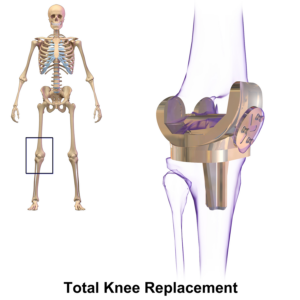How many of the 600,000 knee replacements every year in the U.S. can be prevented with diet and exercise?
Or are some people genetically doomed, as many would like to believe?
The mindset of, “There’s nothing I could have done about it; it’s a natural part of aging,” is designed to alleviate the guilt of failing to take proper care of one’s body.
An investigation concludes that knee osteoarthritis – which often leads to a total knee replacement – can be prevented with exercise and diet.
Who knew? I did!
But years ago I would have never been able to convince my father of that; he sports two artificial knee joints, though he never did regain good walking and painless knees after the surgeries.
The report of the investigation is in Nature Reviews Rheumatology.
My mother won’t believe that exercise and diet could have prevented her husband’s need for total knee replacement surgery.
All along I’ve known that the cause was lack of structured exercise, topped off with SAD: standard American diet.
University of Surrey researchers found a link between osteoarthritis and metabolism.
SAD plus a sedentary lifestyle causes adverse metabolic changes that elicit genetic reprogramming at the cellular level in joints.
Understanding This
No matter how much up to her neck my mother ever was with household and childcare duties, my father never pitched in and instead was seated – either before the TV or at his typewriter, or napping.
Yes, he had his workshop and occasional home projects, but that was far and few in between.
Had my father pitched in with the “mother stuff,” I’d bet the farm he would have never needed total knee replacements! Six thousand more steps a day count!
But from a more scientific perspective, the adverse metabolic changes impede cells’ energy production.
Glucose is overproduced. Excess glucose turns into lactic acid, which then builds up, inflaming knee joint cartilage – leading to pain and mobility problems.
The paper points out that osteoarthritis has been incorrectly known as the “wear and tear disease.”
A study headed by Daniel White, PT, ScD, Sargent College at Boston University in Massachusetts, found that getting at least 6,000 steps a day was associated with a lower risk of mobility problems from osteoarthritis (Arthritis Care & Research, 2014).
Every additional 1,000 steps a day, above the 6,000 threshold, was associated with a 16-18 percent reduction in mobility limitation two years later.
If you don’t want knee replacements to be part of your future, you’d better start cracking down on your exercise habits and clean up your diet.

BruceBlaus/CreativeCommons
A brisk treadmill walk (don’t hold on) for 30 minutes is an easy way to contribute to over 6,000 steps a day.
Another option is buying a treadmill desk to do some of your home computer use on or to watch TV from.










































